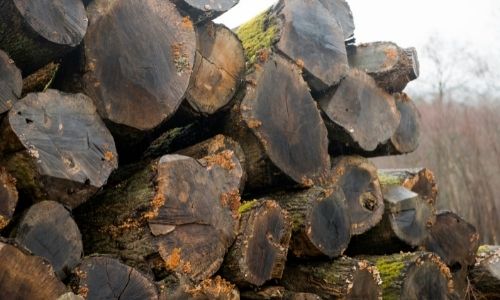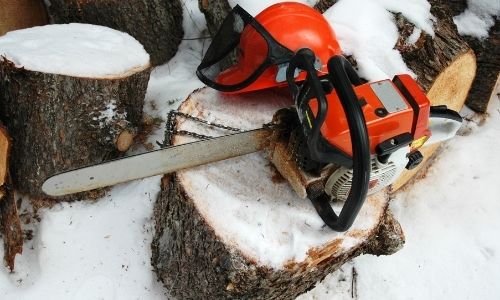There are times when you will be required to work with your chainsaw under wet conditions. You might also be cutting into wet wood, and as such, you might be wondering whether specialized equipment will be required.
You might also be wondering if exposure to water can cause damage to your chainsaw. In the following couple of sections, we will take a look at the issue of chainsaws and whether they get wet or not.
Chainsaws are excellent engineering results of a design process intended to stand up to natural elements such as dew, dust, and rain. Loggers are usually working in weather conditions that are either very humid or raining while they are at work.
For this reason, it is safe to assume that chainsaws are designed to handle a bit of wetness, and proper maintenance is needed for the most effective functioning of your chainsaw.
In their operation, the chainsaws are known to get a bit of moisture, so getting wet is wholly expected. They can get wet when used under certain weather conditions, and while it is in use, you should expect a bit of moisture to accumulate on the chainsaw.
TABLE OF CONTENTS:
Are chainsaws waterproof?
Chainsaws are not designed to be waterproof. For electric chainsaws, you should try as much as possible to stay away from water. You cannot trust the design of the chainsaw when you are working under wet conditions. However, two types of chainsaws can be used underwater.
– Hydraulic chainsaws
– Pneumatic chainsaws
The two chainsaws mentioned above will not require any electricity or gas to run. They do not have any engine or motor that can get water damage, and as such, they can be submerged under the water. However, these are not common among the majority of chainsaw users.
The first operates under the pressure of a liquid inside them and has very few moving parts. The liquid being used to run the chainsaw is usually somewhere different, and as such, it can be used under all kinds of conditions without damage.
Related Article: What should I look for when buying a chainsaw?
A pneumatic chainsaw uses compressed air to make the chain move around. These can be used in tunnels and underwater where you cannot use regular gasoline due to the risk of explosions.
They can cut through a broader range of materials which means that they are an effective tool that can be used under all kinds of conditions.
Can a chainsaw get rained on?

Logging in the rain is something many people are used to doing, and this means that the chainsaw usually gets rained on while it is in use. However, using the chainsaw in the rain requires that you follow several safety precautions to prevent any problems from taking place. For instance, you have to wipe dry the clutch bearings.
You also need to ensure that you have sealed off the fuel tank properly since the water should not be getting in there while using the chainsaw. Also, ensure that your sprocket cover is kept clean at all times as moisture can get inside and start causing your chainsaw to malfunction.
Additionally, you will have to keep an eye on all the control mechanisms in addition to the other safety features that are included in your chainsaw.
Keep the anti-vibration system of your chainsaw insulated from moisture leakages for the best handling of your chainsaw when it has been rained on. If water has gotten into any of the places it should not, take the time to wipe them clean.
When you have dried them effectively, you will be able to use your chainsaw for longer and crucial components such as the chain brakes will last longer. Another precaution that you should consider when you are working under rainy or wet conditions is that you should have anti-slippage footwear that grips the ground more effectively.
This will ensure that you do not slip and fall. Also, reduce the angle you hold while cutting the rood in the rain to improve your cutting. Being extra careful when working in the rain enables you to maintain your chainsaw’s powerful cutting properties, and you will be able to use it for much longer.
Related Article: What is the best way to sharpen a chainsaw blade?
Can electric chainsaws get wet?
No. Electric chainsaws cannot get wet, and they should not be allowed to get wet. Whether they have an extension cord or are battery-powered, your electric chainsaw should not be allowed to be exposed to any moisture or water.
The water is likely to cause a malfunction or a short circuit, which is one of the things that you should avoid.
Your chainsaw should be kept dry for your safety, and you should only use it indoors where it is not exposed to much water or moisture. The water causes damage to the moving parts and the electrical components of the chainsaw, which reduces the overall lifetime and usefulness of your chainsaw.
For this reason, it is essential to be extra careful when you are working with an electric chainsaw as it clearly cannot work correctly when it gets in contact with water. Ensure that your chainsaw does not get ruined by the water, and always ensure that it is stored away in a place where it will not be exposed to any humidity or moisture.
With this in place, you will be able to get a more useful life out of your electric chainsaw, and it will not be getting damaged easily. The components will also last longer, and the chainsaw will be safer for you to use.
Is it OK to use a chainsaw on wet wood?

You can use a chainsaw on wet wood as this is usually the case at some seasons, and as you are logging, you might find yourself working on a wet patch for an entire day.
It is OK if you use your chainsaw on the wet wood, but for the sake of your chainsaw, it is equally essential to ensure that you wipe it dry once you are done cutting the wood. Any wetness on your blades can cause them to start rusting, which also reduces the valuable life that you can get out of your chainsaw.
Also, ensure that you maintain the proper grip on your chainsaw and have footwear to keep you stable on the ground. This way, you will be in more control as you cut through the wood, and you will be able to avoid any slips and falls while you are working.
The wet wood will also be more complicated to cut, which means that your technique should account for the fact that the wood is wet. Cut from a lower angle and ensure that you hold the chainsaw firmly as you cut into the wet wood.
Related Article: Which brand of chainsaw is best?
A lower angle will factor in the wetness of the wood, and it will ensure that the blades of your chainsaw can get into the wood no matter how wet it is. Cutting into dry wood and wet wood also feels vastly different, and as such, you should observe the difference and develop a technique that works best for the wet wood.
Is snow bad for a chainsaw?

By itself, snow and ice have minimal effect on the blades of your chainsaw. The only complication that occurs is when you have snow that has been mixed with mud, dirt, and other forms of debris, which will quickly dull your chainsaw, and it will not be as effective as you would expect it to be.
Frozen wood will also be harder to cut, so you should expect more challenging working in icy conditions.
There is usually a more complex layer on the top of the wood, which means your chain should be as sharp as possible. It would also help let your chainsaw warm-up start melting the ice. To achieve the best cut, ensure that you are cutting at full speed.
Which type of chainsaw is best for wet weather?

The Husqvarna 130 is the best chainsaw to use in wet weather. It is gas-powered, and for this reason, it can work effectively in wet and cold weather. It also has a 16-inch bar, meaning that it can cut down trees and split the wood.
It is also easier to carry around and has a chain brake which ensures that kickback does not happen as you use the chainsaw.
Related Article: Are chainsaws dangerous?
How does an underwater chainsaw work?
The material that powers the chainsaw is usually at the surface and gets to the chainsaw using a system of pipes.
This means that the chainsaw and the material that powers it are held in separate places, and as such, they can work under the water with ease. Most are powered by pressured water, air, and gas, which makes them work with a minimal number of moving components.
They are usually very effective for cutting underwater and will provide you with more reliable results even when using them for many hours. The pumped gas can be held at the boat’s surface while the person handling the chainsaw can be under the water working on the section that needs to be cut.
Conclusion
You should always be careful when using a chainsaw in wet weather, and if you are using an electric chainsaw, you should avoid any kind of moisture – period!
Gas-powered chainsaws can handle a bit of light rain but continued exposure to damp conditions can promote things like corrosion and excess wear on metal parts. If your chainsaw does get wet, it is good practice to dry if off as soon as possible. This will ensure your chainsaw can have a long and productive life!

Leave a Reply